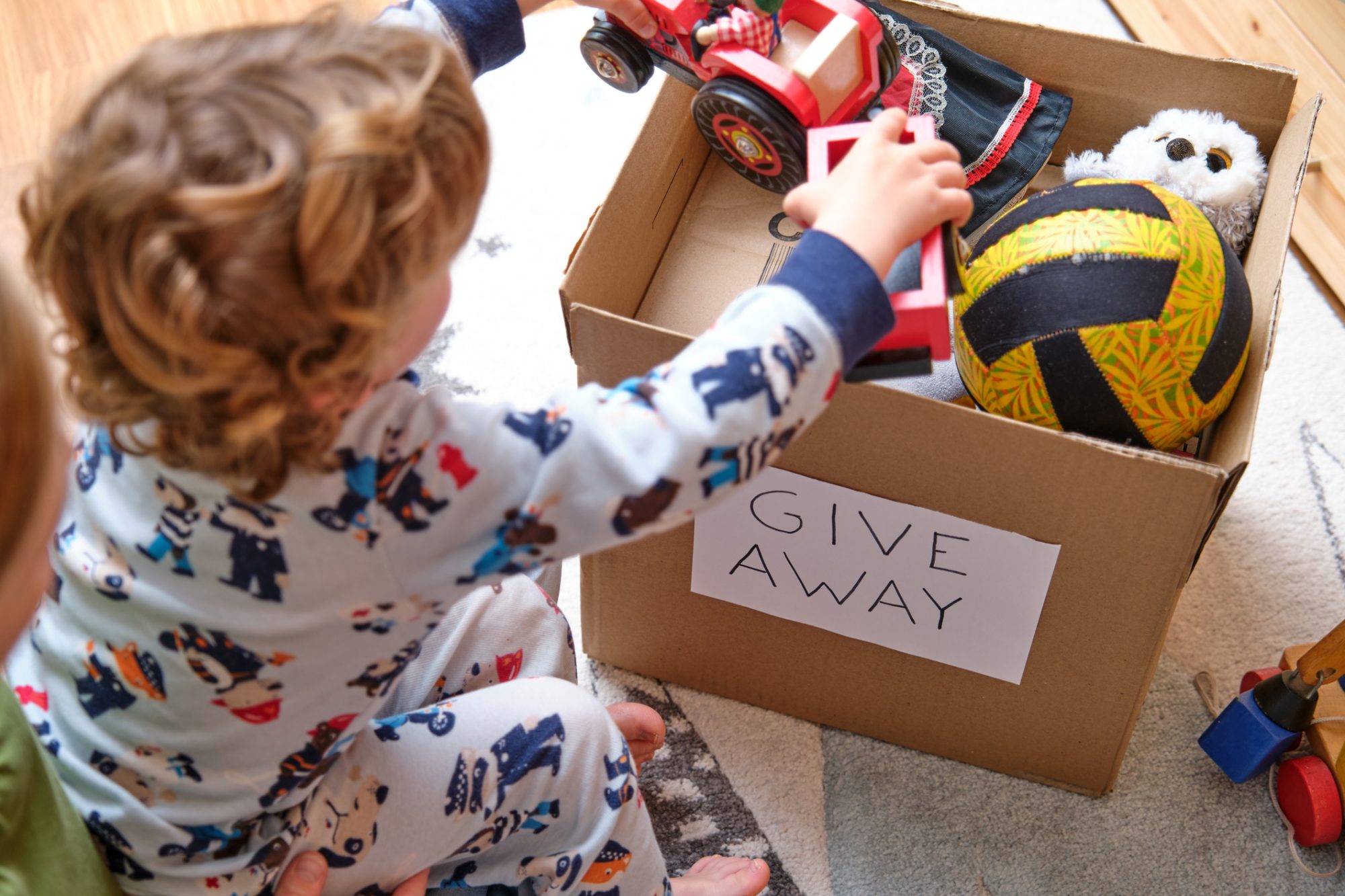Poverty, homelessness, and food insecurity are some longstanding elephants in the American room. And a much as you might like to avoid such uncomfortable topics with your kids, the reality is that all of this exists around you—and around your kids. Sure, wanting to protect children from the harsh realities of the world is natural, but shielding them from the truth is problematic.
According to the National Center for Children in Poverty, 38 percent of children live in low-income families, while one in five children live in poverty. This means that, even if your family isn't struggling with poverty yourselves, you likely cross paths with low-income folks often. Talking to your kids about the realities of poverty isn't just about making them aware; it's an important component of raising compassionate, empathetic, and emotionally intelligent children who acknowledge their own privilege.
Address your own feelings
Before you even discuss poverty, homelessness, and food insecurity with your children, it's important you understand how you feel about it. Be honest with yourself and examine your own biases; whether or not you already talk to your kids about poverty, you are sending them a message each time you are faced with situations involving those in need.
It's important to be sure the message you are sending isn't rooted in discrimination, shaming, or personal insecurities. It will be hard for your children to believe you and act accordingly if you tell them that those in poverty can be good people, yet you visibly judge a person experiencing homelessness when you pass them on the street.
Talking to your kids about the realities of poverty isn’t just about making them aware; it’s an important component of raising compassionate, empathetic, and emotionally intelligent children who acknowledge their own privilege.
"It's an uncomfortable conversation to have, but as parents, you need to be mindful of what and how you are communicating subconsciously to children, because it can shape their opinions, how they perceive poverty, and promote negative views if you are not careful," Dr. Erlanger Turner, clinical psychologist and executive director of Therapy for Black Kids, tells Parents.
So start teaching your children by modeling your own behavior. When you make underhanded comments about people who receive government assistance, your children pick up on it and learn from it—even if poverty isn't openly discussed.
Make it age-appropriate
Experiences you encounter as a family may be the best opportunity to open the discussion. If you see people who are experiencing homelessness, it could be a good time to explain what is going on and find out how your kids are feeling about it, offers Dr. Turner.
Depending on where you live, seeing people living in tents or asking for money on the street can already feel so routine that some children became desensitized to it and don't even ask questions. So point out what's happening, and then ask the kids how it makes them feel, Dr. Turner suggests.
Doing so can give you insight into how your kids perceive what's going on, as well as the chance to give details so that they can better understand the gravity of the situation. Additionally, asking how kids think a person experiencing homelessness might feel is a good way to not only address the situation but personify it, so the child realizes that this affects real people who are deserving of respect and compassion.
With young children, the conversation should be very basic. Sometimes, it's a simple explanation that some people don't have enough food, so we're going to give them some food. If your child's school is organizing a food drive, explain where the food goes, Dr. Turner continues.
Children are amazing observational learners, as Dr. Reena Patel, author, educational psychologist, and behavioral analyst explains to Parents: "Let them share what they know through their own words and actions; that will give you an idea where to start the conversation."
Shows such as Sesame Street, which has a character who is experiencing homelessness, can be helpful in giving ideas and guiding the conversation. Feeding America also has a downloadable family action plan to help parents talk to children about hunger.

Be honest
When discussing the realities of poverty, it's essential to tell kids the truth—without scaring them. The first time many kids hear their parents mention the concepts of homelessness and poverty is via threat, when the child has done something poorly or performed badly in school. Both Drs. Turner and Patel agree this is the wrong approach.
"[Those people] didn't put it upon themselves to be homeless" via bad behavior, explains Dr. Patel. "There is a small percentage of individuals who are homeless because they have a mental illness. Then, there are those who were born into the situation, amongst other reasons."
And of course, success and earning is rarely about working hard vs. slacking off. More often, it's about luck and privilege. As kids get older, you can begin to explain that employment isn't always enough, and that lack of employment doesn't mean the person is a failure or not working hard. Teenagers can start to understand that family size, underemployment, type of job, pay rate, and more can all be factors in how comfortably someone lives—and how easily they may fall on hard times.
"Let them know that this person may be working, but their salary isn't working for them at the moment to provide all they need," Dr. Turner advises. "Or explain that the pandemic led to employment challenges, which could make it harder for some people to get necessities like a hot shower or nutritious food."
Erase the stigma
It's easy tp think that homelessness and food insecurity happen in "other communities." But the reality is, they are likely happening right there in yours, explains Dr. Patel.
And it doesn't help that many people make assumptions regarding what poverty "should" look like. Some assume that if a person is overweight, they couldn't be suffering from hunger; in reality, food insecurity and food deserts mean limited access to grocery stores despite available non-nutritious foods via bodegas, fast-food joints, or food pantries. Or, if you happen to see someone asking for food on a street corner who then gets into a car and drives away, you might assume they're just scamming. However, that's not always the case.
"I think it's important we teach our kids that poverty looks different for everyone," Dr. Patel continues. "There is no one way to look if you are in need." One way of teaching this is by drawing a line down the middle of a piece of paper and having kids identify what things they think are "wants" or privileges vs. what are "needs."
You may find that they identify something like watching television, a toy, having iPad time, or going to a restaurant as a "need." Then, you can challenge things; ask, "is it really a necessity to be able to watch a television show?" This conversation allows kids to shift perspective in recognizing that we all have different "necessities."
Avoid saying things like “less fortunate” or “poor” and instead, use words such as “in need” or “underserved.”
Furthermore, this can lead to a conversation about access, says Dr. Turner. Having the right access to certain resources for education and work, such as an ipad or laptop and wi-fi, is a big component in the prevention of poverty.
Explain to your kids that there are going to be people in your community who are not as well off as others. And what does that mean?
Additionally, the ability to discuss that poverty isn't a personal failing can be helpful. It's not the person who is the problem; it's their situation, the lack of resources, and the class system of the society, both experts explain. Explain to kids that rather than being "lazy" or "dirty," someone's issue may simply be lack of money or access to food; it's likely not because of something they may have done wrong.
"Explain that it's not intentional on their part. We're all fighting our own battles, and that looks different for everyone," says Dr. Patel.
Finally, being mindful of the language you use when talking about these issues can also assist in open discussions that move away from vilifying those in poverty and instead move towards erasing the stigma. Dr. Patel suggests parents avoid saying things like "less fortunate" or "poor" and instead, use words such as "in need" or "underserved."
Instill hope and take action
Addressing the needs and struggles of those in poverty can sometimes lead to big emotions in children, including guilt over the things they do have. Simply remind your kids that despite the unfairness of life, it's ok that they have what they do.
"It's ok to be who you are and have the privilege that you have," says Dr. Patel. It's what you do with that privilege—how you act to live your life generously and in aid of others—that counts.
The acknowledgment of your kids' gratitude for what they have can naturally lead to a conversation about how they can use that privilege for good. Help them brainstorm ways they can extend help and kindness to others. Upcycle their gently used toys and clothes that other kids can enjoy. Look for volunteer opportunities in your community or even at home; companies such as Alltruists offer at-home volunteer boxes for kids to make cards and keychains for children who are moving into a new home after combatting homelessness. All of these actions are good starts in teaching your kids to think of others, share, and express gratitude.
Still, kids need to know that the burden of fixing poverty isn't placed solely on them, concludes Dr. Turner. Explain to them that while their own good deeds, alongside taxes and charitable organizations, do help, it's about changing the system and society into one that leaves fewer vulnerable individuals behind to struggle with homelessness, poverty, and food insecurity. So really, the most important thing you can teach your kids here is to vote.





